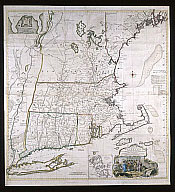The Economy of New England

1755 Map of New England
By the beginning of the 18th century, New England possessed the fewest commercial connections with Britain of the four colonial American regions. The original New England colonies—Massachusetts, Rhode Island, Connecticut, and New Hampshire—were founded by people seeking distance from Britain and this separation was also reflected in the region's economy. Moreover the northern soil hindered development of any major export crop. Fish was the area's most valuable export throughout the colonial period, though its primary trade destination shifted over the eighteenth century. By 1768, few of New England's goods (fish, whale products, livestock, salt meat, and lumber) were headed to Britain; they were instead being sent to the West Indies. In return New Englanders received sugar and molasses for their growing rum distilling industry, thereby reducing the region's commercial ties to Britain even further. This shift also had direct political implications, rendering merchants and distillers (and smugglers) especially sensitive to changes in trade regulations that impacted sugar. For example, the Molasses Act of 1733 and the Sugar Act of 1764, of little concern to other colonies, were of great interest—and continued consternation—to New Englanders. The region was also a major builder of ships, given the readily available materials, for English and Scots merchants, as well as for the American coastal trade. In fact, by 1776 a third of all British commercial shipping vessels had been built in New England.




